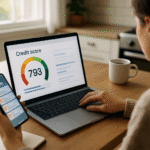If you’re a millennial juggling rent or a mortgage, student loans, and the rising cost of everything, squeezing more return from your cash matters. High-interest (aka high-yield) savings accounts can be a sweet spot: they’re liquid, typically fee-free, and federally insured when opened at banks or credit unions. This guide spotlights the top 5 high-interest savings accounts for millennials, explains how to pick the right option for your situation, and shows you exactly how to set one up and start earning more—without turning into a full-time rate chaser. We’ll also cover safety basics, common pitfalls, and a simple four-week starter plan.
Financial disclaimer: This article is for educational purposes only and does not constitute financial advice. Consult a qualified professional for guidance tailored to your specific circumstances.
Key takeaways
- Millennials can boost cash returns by moving idle funds into high-interest savings accounts with competitive APYs and low fees.
- Rates change frequently—treat listed APYs as snapshots and verify current terms before opening.
- FDIC/NCUA insurance matters: keep total deposits per ownership category within insured limits or structure across institutions when needed.
- Automations win: set direct deposit splits and recurring transfers so your savings happens on autopilot.
- Track simple KPIs—APY, total interest earned, savings rate (% of income saved), and days of expenses covered—to measure progress.
How we selected the top 5 (in plain English)
- Consumer-friendly features: no monthly fees, no/low minimums, intuitive apps, and easy transfers.
- Competitive APYs for easy-access savings as of August 14, 2025 (not teaser-only rates).
- Clear requirements: if you must jump through hoops (e.g., a monthly direct deposit threshold), you’ll see that called out.
- Solid reputation & transparency: straightforward disclosures, real-world usability, and recognizable servicing where possible.
Note on geography: Rates and offers vary by country. The five accounts below focus on U.S.-available options that are widely accessible online. If you bank outside the U.S., use the selection criteria, safety tips, and starter plan here to find local equivalents.
Quick-start checklist (read this first)
- Define the job of your cash: emergency fund, travel, down payment, or short-term holding between investments.
- Target size: 3–6 months of essential expenses is a common benchmark for emergency funds.
- Check insurance limits: keep per-institution balances within insured thresholds per ownership category.
- Pick the account that matches your habits (e.g., will you maintain direct deposit? do you need ATM access?).
- Automate: set up automatic transfers or direct deposit splits on payday.
- Track KPIs monthly: APY, interest earned, savings rate, and emergency-fund months covered.
The Top 5 High-Interest Savings Accounts (and how to use them)
APYs below are as of August 14, 2025 and can change anytime. Always verify current rates and terms before opening.
1) UFB Direct High Yield Savings
What it is & why millennials like it
UFB Direct’s high-yield savings consistently trends near the top of easy-access rates, without monthly maintenance fees or minimum deposit requirements. It’s straight to the point: strong base APY, a modern app, and a complimentary ATM card—handy if you want access to cash without moving money to checking first.
Requirements / prerequisites
- Government-issued ID, SSN/ITIN, U.S. address.
- Existing checking account to fund via ACH or debit card (optional if depositing via mobile check or transfers).
- Cost: No monthly maintenance service fees.
- Low-cost alternative: If you don’t need an ATM card, other online banks with similar APYs may also fit (see Honorable Mentions).
Step-by-step to open & optimize
- Open online: Provide ID, SSN, and funding details.
- Link your paycheck: Use a small direct deposit split (e.g., 10% of net pay) into UFB to start.
- Create sub-savings “buckets” in your budget app (not all bank apps have built-in buckets)—Emergency, Travel, Taxes, Down Payment.
- Turn on alerts: balance, large deposit, and low balance.
- Review quarterly: compare your APY with market leaders; switch only if the gap is meaningful after tax (and worth the hassle).
Beginner modifications & progressions
- Beginner: Start with auto-transfers of $25–$50 per week.
- Level up: Add an ATM card only if you truly need it—access makes spending too easy for some savers.
- Advanced: Pair with a high-yield checking or money market if you want debit convenience without draining savings.
Recommended frequency / metrics
- Automation: weekly transfer or paycheck split.
- KPIs: Current APY, monthly interest earned, months of expenses saved.
Safety, caveats & common mistakes
- Rates are variable and move with market conditions.
- Avoid keeping over-insurance-limit balances in one ownership category at a single institution.
Mini-plan example
- Today: Open the account; fund $100.
- This week: Set a $50 weekly transfer.
- This month: Move an additional $200 from low-yield cash; turn on alerts.
2) Varo Bank High-Yield Savings (up to 5.00% APY—requirements apply)
What it is & why millennials like it
Varo’s High-Yield Savings offers an eye-catching top APY on a portion of your balance when you meet simple monthly requirements. For millennials already using digital banking and direct deposit, it’s an easy “set-and-forget” way to elevate cash returns.
Requirements / prerequisites
To unlock the top APY (up to 5.00%) on a limited balance tier (commonly up to $5,000), you typically must:
- Hold both a Varo Bank Account and a Varo Savings Account.
- Receive eligible direct deposits (e.g., at least $1,000 in a month, subject to the bank’s current definition).
- Keep accounts non-negative at month-end.
- Cost: No monthly maintenance fee on the savings account.
Step-by-step to open & optimize
- Open both accounts (checking + savings).
- Set direct deposit from your employer; if full DD feels risky, split a portion to Varo.
- Automate transfers on payday into savings to capture the top APY on the eligible tier.
- Calendar reminders: check you still meet deposit requirements each month.
Beginner modifications & progressions
- Beginner: Start with partial direct deposit (e.g., $300/paycheck) while testing the app workflow.
- Level up: Max the eligible APY tier (e.g., maintain up to $5,000).
- Advanced: Keep surplus beyond the top-APY tier in a second high-yield account if rates are better there.
Recommended frequency / metrics
- Monthly check: confirm direct deposit hit and you’re meeting requirements.
- KPIs: days remaining to qualify this cycle, eligible balance filled, interest earned.
Safety, caveats & common mistakes
- Don’t forget the rules: if you miss the deposit requirement, your APY reverts to the standard rate for that period.
- Keep balances under insurance limits across institutions.
Mini-plan example
- Today: Open the accounts; set up a $1,000 monthly direct deposit.
- This week: Transfer $1,000 to fill the top-APY tier.
- End of month: Verify accounts are non-negative and interest posted as expected.
3) Marcus by Goldman Sachs Online Savings
What it is & why millennials like it
Marcus is a no-fee, $0 to open online savings account with a competitive APY and a clean, straightforward user experience. It’s popular for simplicity—no bundling mandates, no tricky fee traps.
Requirements / prerequisites
- ID/SSN, U.S. address, and a funding account.
- Cost: No monthly fees.
- Access: Online and mobile. Marcus advertises unlimited withdrawals (subject to change), a convenient feature for managing short-term goals.
Step-by-step to open & optimize
- Apply online and verify external account(s).
- Create goal-based “envelopes” in your budgeting tool to mimic buckets.
- Automate a weekly transfer for your emergency fund plus a monthly transfer for a short-term goal (e.g., travel).
Beginner modifications & progressions
- Beginner: $25 weekly automation until you hit $1,000.
- Level up: Increase automation after any pay raise or bonus.
- Advanced: If you need more predictability, pair with a short-term no-penalty CD for a portion of your cash.
Recommended frequency / metrics
- Weekly/biweekly automations align with paycheck cycles.
- KPIs: APY, interest earned, and number of months of expenses saved.
Safety, caveats & common mistakes
- Variable rate: your APY can change.
- Avoid over-consolidating at one bank if you’re near insurance caps.
Mini-plan example
- Today: Open and fund $100.
- This week: Automate $50/week.
- This month: Bring your emergency fund to one month of expenses.
4) American Express High Yield Savings
What it is & why millennials like it
A familiar brand with a clean interface, $0 minimum to open, and no monthly fees. It’s a strong “default” account if you want a recognizable name, a stable app, and solid customer service reputation, even if it’s not always the single top rate on the market.
Requirements / prerequisites
- ID/SSN, funding account.
- Cost: No monthly fee; $0 minimum to open and to earn the stated APY (subject to change).
- Low-cost alternative: If you want similar simplicity with slightly different features, see Ally or Discover in Honorable Mentions.
Step-by-step to open & optimize
- Apply online, link your checking account.
- Automate a % of each paycheck (e.g., 10% to emergency, 5% to travel).
- Set alerts for large deposits and monthly interest.
Beginner modifications & progressions
- Beginner: Automate $20–$50 weekly while learning the app.
- Level up: Layer a goal-based rule: every time you buy coffee out, transfer $3 to savings.
- Advanced: Pair with a short-term CD ladder for near-term spending you won’t touch for a few months.
Recommended frequency / metrics
- Paycheck-synced automation.
- KPIs: interest earned vs. previous bank; time to goal.
Safety, caveats & common mistakes
- Transfers can take a couple of business days; plan around bills.
- Don’t chase teaser promos if they complicate your setup without meaningful gain.
Mini-plan example
- Today: Open, fund $200.
- This week: Set 10% paycheck split directly to AmEx Savings.
- This month: Review interest earned and decide whether to raise automation by 1–2%.
5) Ally Bank Online Savings
What it is & why millennials like it
Ally layers a competitive APY with clever tools like “buckets” (category-based sub-accounts) and round-ups/boosters. If you’re a visual goal-setter, the interface makes saving feel tangible—perfect for multiple short-term goals.
Requirements / prerequisites
- ID/SSN and funding account.
- Cost: $0 minimum to open; no monthly maintenance fee.
- Internal policies: Ally typically limits certain types of withdrawals (e.g., up to 10 per statement cycle).
Step-by-step to open & optimize
- Apply online; link external accounts.
- Create buckets (Emergency, Car Repairs, Travel, Gifts).
- Automate per bucket (e.g., $50/week to Emergency; $25/week to Travel).
- Turn on round-ups if you also have Ally checking, to sweep change into savings.
Beginner modifications & progressions
- Beginner: One bucket only—Emergency—until you hit $1,000.
- Level up: Add 2–3 buckets and split automation 70/30 between Emergency and your top discretionary goal.
- Advanced: If you’re near insurance limits, open an additional high-yield savings elsewhere for overflow.
Recommended frequency / metrics
- Weekly automations to smooth cash flow.
- KPIs: bucket balances, total months of expenses, APY and interest trend.
Safety, caveats & common mistakes
- Variable rate.
- Be mindful of transaction limits to avoid potential excess withdrawal restrictions.
Mini-plan example
- Today: Open and create three buckets.
- This week: Automate $75/week split across buckets.
- This month: Reallocate +$25/week from low-priority bucket to Emergency.
Honorable mentions & when they make sense
SoFi Checking & Savings
- Great if you already direct deposit. With eligible direct deposit, savings APY is competitive, and there may be limited-time boosts via the membership program. Ideal for people who want checking + savings under one roof and a slick app.
Capital One 360 Performance Savings
- A widely used option with a competitive APY, easy interface, and strong mobile app. Pro tip: make sure you’re in the Performance Savings product (not older product types), and keep an eye on ongoing legal and settlement developments that have been reported in the news so you understand your account type and rate.
Discover Online Savings
- No monthly fees, no minimum to open, and a competitive APY from a large, well-known online bank. Great for those who value a simple, dependable experience.
Barclays Tiered Savings
- For larger balances, tiered APY can be attractive. If you’re parking higher sums (e.g., building a down payment over a short horizon), run the math to see if the tier you qualify for beats your current account.
How to choose the best account for you (in 5 minutes)
- Write down the job: emergency fund vs. short-term goal.
- Decide on direct deposit: If you can meet a direct-deposit threshold easily, consider accounts with boosted APYs. If not, favor no-strings high base rates.
- Check your habits: Will an ATM card tempt you to spend? If yes, avoid accounts with easy card access.
- Mind insurance: If you’ve got significant cash, split across institutions/ownership categories to stay insured.
- Add automation: Pick the account whose app features help you save without thinking.
Troubleshooting & common pitfalls
- “My APY dropped suddenly.” Rates are variable. Compare current APY with market leaders quarterly; switch only if the after-tax gain is meaningful relative to the hassle.
- “I missed the requirements for a boosted APY.” Set calendar nudges a few days before month-end to confirm your direct deposit hit and your account isn’t negative.
- “Transfers are slow.” Link two external accounts for flexibility and plan 1–3 business days for ACH.
- “I went over insurance limits.” Move overflow to another FDIC/NCUA-insured institution or restructure via ownership categories if appropriate.
- “Too many withdrawals.” Some institutions limit certain types of withdrawals per cycle—batch transfers to stay well below any cap.
- “I’m overwhelmed by choices.” Choose any of the top five, automate a small weekly amount, and iterate later. Doing something beats waiting for perfect.
How to measure your progress (simple KPIs)
- APY: current annual percentage yield on your savings account(s).
- Interest earned (monthly & YTD): tells you if switching accounts actually helped.
- Savings rate: percentage of take-home pay you save; aim to steadily nudge this higher (e.g., +1% each quarter).
- Emergency-fund months: essential expenses covered if income stops; target 3–6 months.
- Liquidity buffer: cash available within 1–3 business days (your high-interest savings should qualify).
A 4-week starter plan (do this and you’ll be 90% of the way there)
Week 1: Pick & open
- Choose one account from the Top 5.
- Open online, link your main checking, and fund with $100–$300 to get started.
Week 2: Automate
- Set paycheck split (e.g., 10%) or a weekly transfer ($50–$150).
- Turn on app alerts: deposits, interest posted, low balance.
Week 3: Organize goals
- If your bank has buckets, create them; otherwise use your budgeting app.
- Assign dollar targets for each goal and align automations accordingly.
Week 4: Optimize & protect
- Check your APY and monthly interest.
- Confirm insurance coverage is adequate; if you’re above limits, open a second account and split balances.
- Calendar a quarterly review to reassess APY and contributions.
FAQs
1) Are high-interest savings accounts safe?
Yes—when held at insured institutions. Bank savings are generally FDIC-insured, and credit union savings are NCUA-insured, typically up to $250,000 per depositor per ownership category. Always confirm your institution’s coverage and stay within limits.
2) Why did my APY change?
Most high-yield savings accounts have variable rates that respond to market conditions. Expect them to rise and fall. That’s normal.
3) Is it worth switching accounts for 0.20% more APY?
It depends on your balance and tax bracket. On $10,000, a 0.20% APY bump is $20/year before tax. Decide if the extra money is worth the setup time.
4) How do I qualify for “up to” APYs?
Some banks offer boosted APYs for meeting specific requirements like monthly direct deposits and/or maintaining non-negative balances. If you miss a requirement, you usually earn a lower base APY for that period.
5) Should I keep my emergency fund in one account or split it?
Start with one account for simplicity. If your balance grows near insurance caps or you want to diversify rate risk, open a second account and split.
6) Can I access my money quickly?
Yes. Transfers typically take 1–3 business days. Some accounts provide ATM access, but consider whether that tempts overspending.
7) What about money market accounts or CDs?
They’re fine alternatives for specific needs. Money market accounts sometimes offer check/ATM access; CDs may pay more but lock funds for a term. For emergency funds, liquidity usually beats slightly higher yield.
8) How much should I keep in high-yield savings vs. investing?
Keep your emergency fund and near-term goals in savings. Invest long-term funds according to your risk tolerance and timeline. If uncertain, consult a professional.
9) Do these accounts charge fees?
The top picks here don’t charge monthly maintenance fees, but always read fee schedules for wire transfers, returned items, or excess transactions.
10) Will opening multiple savings accounts hurt my credit?
Savings account openings generally don’t affect your credit score. Banks may check ChexSystems/consumer banking reports instead.
11) I saw a headline about banks lowering rates. Should I panic?
No. Rates are variable and move with the rate cycle. The fix is simple: review quarterly and move if the spread is meaningful.
12) I still have cash sitting in a 0.01% account. What’s my first move?
Open one of the top picks, automate a transfer, and set a reminder to close or drain the low-yield account once you’re confident your new setup works.
Conclusion
You don’t need to hunt endlessly for the “perfect” savings account. Pick a high-interest, low-hassle option, turn on automation, and keep an eye on insurance limits and your quarterly APY review. That’s it. Do those three things and your cash will work harder—every single month.
CTA: Ready to earn more on your cash? Open one of the top picks today and automate your first transfer in five minutes.
References
- Best High-Yield Savings Accounts of August 2025, NerdWallet, updated Aug 2025.
https://www.nerdwallet.com/best/banking/high-yield-online-savings-accountsNerdWallet - UFB Direct — High Yield Savings Account (features and APY disclosures), UFB Direct, accessed Aug 14, 2025.
https://www.ufbdirect.com/savings/high-yield-savings-accountufbdirect.com - UFB Direct — Checking & Savings Bundle (APY details), UFB Direct, APY accurate as of 08/14/2025.
https://www.ufbdirect.com/ufbdirect.com - Varo Bank — High-Yield Savings (requirements for up to 5.00% APY), Varo Bank, accessed Aug 14, 2025.
https://www.varomoney.com/high-yield-savings-account/Varo Bank - Today’s best savings account rates highlights (Varo up to 5.00% APY context), The Motley Fool, Aug 14, 2025.
https://www.fool.com/money/banks/articles/top-savings-account-rates-today-august-14-2025/The Motley Fool - Marcus by Goldman Sachs — Online Savings Products (rate and “unlimited withdrawals”), Goldman Sachs Bank USA, accessed Aug 14, 2025.
https://www.marcus.com/us/en/savings/savings1Marcus - Marcus by Goldman Sachs — Online Savings (rate disclosures), Goldman Sachs Bank USA, accessed Aug 14, 2025.
https://www.marcus.com/us/en/savings/high-yield-savingsMarcus - American Express® High Yield Savings — Rate & terms, American Express National Bank, APY accurate as of 08/14/2025.
https://www.americanexpress.com/en-us/banking/online-savings/high-yield-savings-account/American Express - American Express Savings Account Rates (3.50% APY summary), MarketWatch Guides, Aug 2025.
https://www.marketwatch.com/financial-guides/banking/american-express-savings-rates/MarketWatch - Ally Bank — View Rates & Disclosures (APY date, transaction limit notes), Ally Bank, APYs accurate as of 8/12/2025.
https://www.ally.com/bank/view-rates/Ally - Ally Savings Account Rate (3.50% APY summary), MarketWatch Guides, Aug 2025.
https://www.marketwatch.com/financial-guides/banking/ally-savings-account-rates/MarketWatch - SoFi Banking — Savings APY with eligible direct deposit, SoFi, accessed Aug 14, 2025.
https://www.sofi.com/banking/SoFi - SoFi Plus — Limited-time APY Boost details, SoFi, terms as of 8/5/2025.
https://www.sofi.com/sofi-plus/SoFi - Capital One 360 Performance Savings — Features & rate page, Capital One, effective 8/12–8/13/2025.
https://www.capitalone.com/bank/savings-accounts/online-performance-savings-account/features/Capital One - Capital One 360 Performance Savings (rate summary, Aug 12, 2025), Fortune, Aug 8, 2025.
https://fortune.com/article/best-savings-account-rates-8-8-2025/Fortune






